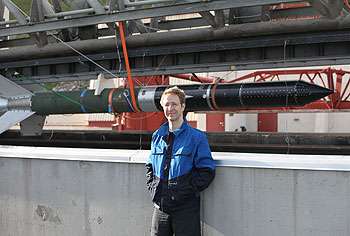Dillon Hunt. Credit: Donald Cook, DSTO
(Phys.org)—A hypersonic flight experiment at eight times the speed of sound, led by a University of Queensland PhD student, has safely launched in Norway.
PhD student Dillon Hunt, a senior mission systems engineer with Australia's Defence Science and Technology Organisation (DSTO), was scientific and technical lead for the trial.
It involved scientists from four nations and held at the Andøya Rocket Range, 300km inside the Arctic Circle, in September.
Mr Hunt was assisted by his colleagues from DSTO as well as Dr Sandy Tirtey, Ms Amy Dedman and Dr Brad Sharp from UQ, who were there for training purposes for the SCRAMSPACE flight which will occur in the near future.
The flight was the fifth in a series of nine flight trials being conducted in the Hypersonics International Flight Research Experimentation (HIFiRE) program.
The HIFiRE program aims to learn more about hypersonic flight (speeds above Mach five), and consists of a series of experiments flown on several sounding rockets.
The experiments compare flight data with information from experimental ground test facilities and computer models.
Mr Hunt said the mission was successfully conducted without incident and was a technical success in testing previously un-flown software and hardware and obtaining extensive data.
"The data is being analysed and we expect to determine the success of the experiment in the New Year," Mr Hunt said.
"Overall it was a collaborative success, with DSTO working with US Air Force Research Laboratory, UQ , the Andøya Rocket Range and the German Aerospace Center, which provided the mobile launcher.
"There are many triumphs and failures encountered in delivering this complex technology which pushes the boundary of human knowledge.
"However, this experiment was a great experience for everybody and has made a significant contribution towards hypersonic flight, even before the flight test started."
In the latest experiment, an air-breathing scramjet engine and its support module with a two-stage rocket booster were launched to an altitude of 350km above the Earth.
Mr Hunt said the scramjet experiment was conducted during descent at speeds of up to Mach 8 (9000km an hour).
The experiment was planned for a precious few seconds at altitudes between 32km and 25km above the Earth.
Measurements taken during the flight were transmitted to four ground stations, three in Norway and one in Sweden.
A similar engine had previously been tested in UQ's T4 ground test facility at the University's St Lucia campus.
Mr Hunt is part of the Pullenvale, Brisbane-based DSTO team that had its origins in UQ's Centre for Hypersonics, School of Mechanical and Mining Engineering, at the University's St Lucia campus.
He has been involved in seven hypersonics flight experiments, including being the technical lead for the UQ-led HyShot III and HyShot IV flights in Woomera, South Australia, and conducting experimental tests at UQ's T4 ground test facility and at the University of Southern Queensland.
"I feel extremely fortunate that my UQ studies have aided me in my career in literally one of the fastest moving fields in the world," he said.
Pioneering work in the HyShot program in UQ's Centre for Hypersonics has proved that scramjets can work in experimental conditions and in flight, and has underpinned many subsequent advances.
This work has not only led to the development of new scramjet engines, capable of flying at eight to 10 times the speed of sound, but also other advances, such as the development of new materials capable of withstanding the extreme conditions such equipment must face.
With the inclusion of UQ masters, PhDs and postdoctoral fellows on research teams in ground, computer and flight tests over the years, hypersonics programs have also helped train the next generation of aeronautical scientists.
Researchers from UQ, DSTO, AFRL and Boeing in September were honoured with the prestigious von Karman Award for international Co-operation in Aeronautics for their work in developing hypersonic flight technology, and presented a paper on the HIFiRE program at the International Congress on Aeronautics.
The University of Queensland is directly involved in three flights in the HIFiRE series funded by an $8.5 million Queensland Government National and International Research Alliances partnership between UQ, the Queensland Government, Boeing and DSTO.
Indirectly, UQ has been involved with all the other flights of the HIFiRE program and as such has provided opportunities for all levels at UQ.
It is expected that the first of these flights will be conducted in July 2013, with two more flights in 2014 and 2015.
Provided by University of Queensland





















